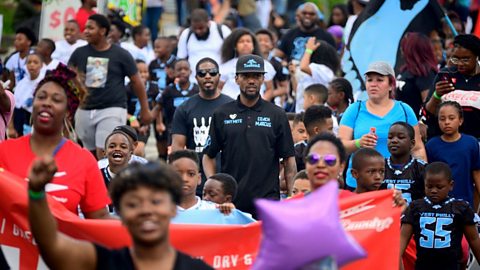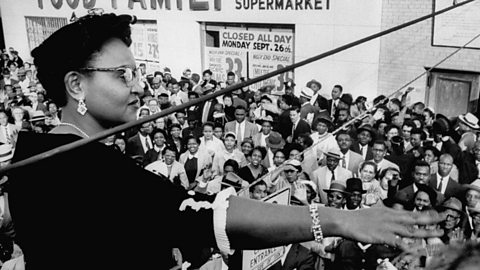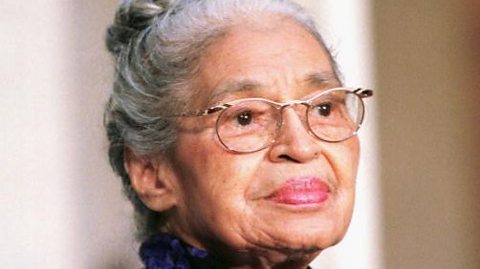On 19 June 1865, enslaved people in Galveston, Texas, received momentous news: slavery had been abolished. They were free.
The day became known as Juneteenth, a word created by joining the words тАШJuneтАЩ and тАШnineteenthтАЩ together, and has been celebrated every year by African-American people to commemorate the end of slavery. It's also known as Emancipation Day, Juneteenth Independence Day, or Cel-Liberation Day.
Juneteenth is widely celebrated across the US, and for many the day became even more poignant after George Floyd's death in 2020 and the demonstrations in support of the Black Live Matters movement. However, it was declared a national holiday in the US only in 2021, when President Joe Biden signed the Juneteenth National Independence Day Act.
Although the day has a very rich history and a special meaning for families all over the States, outside of the US many people haven't heard about it. From the first Juneteenth celebrations to traditional red food and drink, we've put together some facts to get you started, with the help of black history educator Linford Sweeney.

Slavery was actually abolished two years earlier
The argument about slavery was one of the main reasons behind the American Civil War, which broke out in 1861. At that time, Northern States (known as the Union States) did not allow slavery and Southern States (known as Confederates) did.
In January 1863, Lincoln had issued the , which made slavery illegal. More than three and a half million enslaved people living in the Confederate states in the south were declared to be free.
But this freedom depended on the Northern states winning the war. In April 1865, Confederate General Robert E. Lee surrendered his troops to Union General Ulysses S. Grant and, two months later, Union soldiers arrived in Galveston. At that point, 250,000 people were still enslaved in Texas, with no knowledge that slavery had been abolished.
As Texas remained a Confederate state until 1865, it wouldn't have implemented the Emancipation Proclamation until it surrendered to the Union Army. However, some also argue that Texan slave owners kept the news to themselves for as long as possible.
We may never know exactly what happened in those crucial months and years, but we know that the emancipation of 250,000 enslaved people in Texas happened over two years after the Emancipation Proclamation was issued.


A brief timeline of slavery in the US
- 1619 - Some of the first people to be enslaved from Africa are purchased in Virginia by English colonists, though slavery had been used by European colonists long before
- 1788 - The US constitution is ratified; under it, enslaved people are considered by law to be three-fifths of a person
- 1808 - President Thomas Jefferson officially ends the African slave trade, but domestic slave trade, particularly in the southern states, begins to grow
- 1822 - Freed African-Americans found Liberia in West Africa as a new home for freed enslaved people
- 1860 - Abraham Lincoln becomes president of the US; the southern states secede and the Civil War begins the following year
- 1862 - President Lincoln's Emancipation Proclamation frees all enslaved people in the seceded states
- 1865 - The South loses the war; the 13th Amendment to the Constitution formally abolishes slavery
- 1868 - The 14th Amendment grants freed African Americans citizenship
- 1870 - The 15th Amendment gives African American men the right to vote; the South begins passing segregation laws

The end of slavery didn't mean equality
The outlawing of slavery in 1865 did not mean black and white Americans were treated equally.
Because of what was then known as the Jim Crow laws, which denied black people equal rights, Juneteenth celebrations declined until the Civil Rights Movement of the 1960s. These laws were created to force black people to live, work, and play separately. This was known as segregation. It sought to remove their rights to vote, to be educated, apply for senior job positions, get good health care, and much more. Black people were not permitted to use public places, such as parks. It was like slavery had never ended.
In the 1870s, African Americans pooled together $800 and purchased 10 acres of land where Juneteenth celebrations could be held, which they called Emancipation Park. During the years of segregation in Texas, it was the only public park and swimming pool in the Houston area that was open to African Americans, and remained so until the 1950s.
Fast-forward to 1968, when the Poor PeopleтАЩs Campaign held a Juneteenth Solidarity Day, reviving interest in the holiday.
The first Juneteenth
The first Juneteenth celebrations took place in Texas in 1866, with family events such as meals, parades, musical performance and prayers.
As time went by, the descendants of those who had been enslaved became part of the celebrations too, and some families would travel to Galveston to commemorate the event. Different communities developed their own traditions, which followed them if they relocated to different parts of the USA.
Juneteenth became an official state holiday in Texas in 1980.

Today, it is celebrated with red food and fizzy juice
Juneteenth celebrations and traditions vary across the US. As well as public readings and singing, picnics and church services, in some states rodeos, contests, concerts and parades are also organised.
Food plays an important part, with barbecues being one of the most popular ways of marking the day with family and friends. Red food - such as cakes containing red food colouring or red fruit - and drink are particularly widespread, and many people will drink 'red soda water' or strawberry soda. The origins of this tradition are unclear, but red drinks are thought to be linked to the fruits of two native West African plants: the kola nut and hibiscus.
There's also a dish that's become a bit of a legend in recent years: the Marcus Garvey salad with red, green, and black beans. The salad is named after the black activist who created the Universal Negro Improvement Association, which attracted two million followers in the United States. Websites and resources about Juneteenth often mention it as a typical celebratory dish but, apart from an overview of the main ingredients, a precise recipe is very hard to come across.
This article was published in June 2020 and was last updated in June 2022
Six key events in black history you may not know about
The Bristol bus boycott, the killing of Emmett Till and other events you may not have heard about.

Six women who stood up to be counted
They spoke out on civil rights, sports, suffrage and other issues.

The Civil Rights Movement. revision-guide
People who fought for freedoms in America
